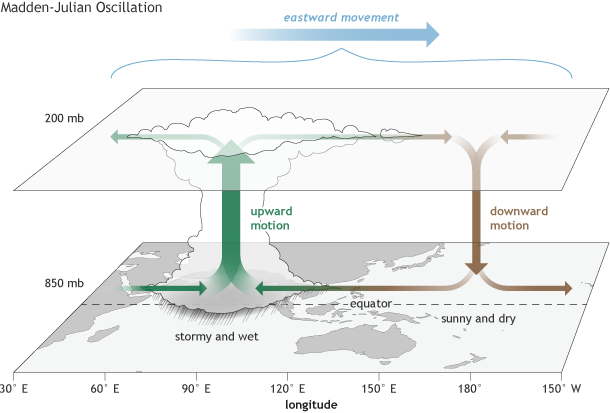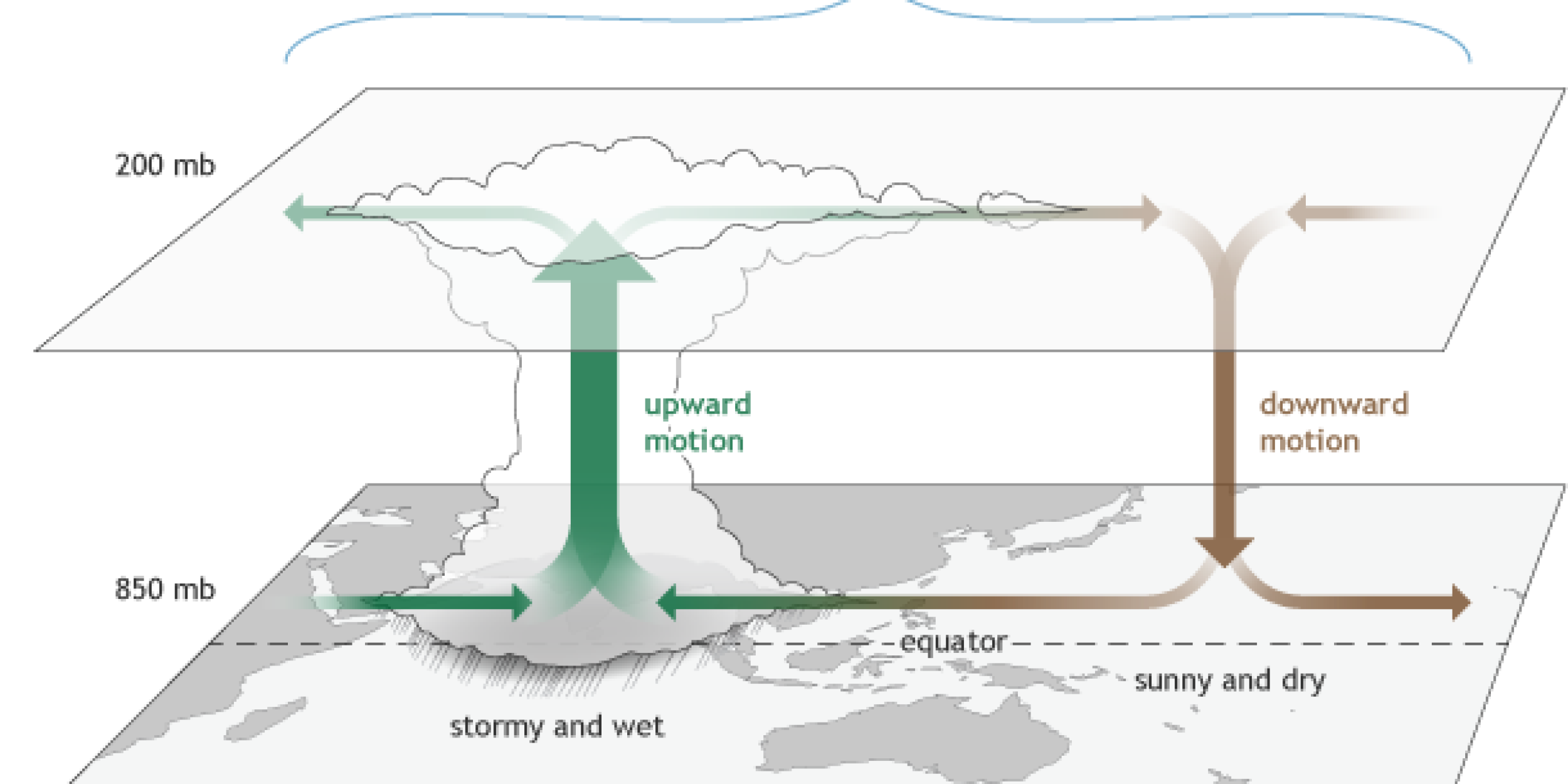A research team, funded in part by the Climate Program Office’s Modeling, Analysis, Predictions, and Projections (MAPP) Program and Climate, Variability, and Predictability Program, has published a new Journal of Climate paper investigating the effect of global warming on a major climate pattern called the Madden-Julian Oscillation (MJO). The investigators found that MJO should be split into two components—wind and precipitation—in order to analyze global warming’s effect on it. Hien Bui and Eric Maloney at Colorado State University’s Department of Atmospheric Science completed the research.
The MJO, a critically important climate phenomenon discovered in 1971, is an eastward moving pulse of clouds, precipitation, wind, and pressure in the tropics that affects weather phenomena such as hurricanes, monsoons, atmospheric rivers, flooding events, droughts, and heat waves. Global warming can impact MJO and other large-scale climate phenomena such as the El Niño Southern Oscillation and the North Atlantic Oscillation.

The surface and upper-atmosphere structure of the MJO when wet, stormy weather is centered over the Indian Ocean and dry weather is centered over the west-central Pacific Ocean. The entire system shifts eastward, circling the globe, and eventually returning to its point of origin. Source: Climate.gov drawing by Fiona Martin
“We looked at two different measures of how the MJO may change in a future warmer climate,” explained Eric Maloney, co-author of the study, “its precipitation variations and its wind variations. Our research really keys in on what controls future MJO precipitation because there was something really puzzling to us about what past models have shown.”
When examining how future warming will affect the MJO, models have shown that moisture in the lower atmosphere (where most weather phenomena occur) will increase with warming. Theoretically, this would augment precipitation associated with active MJO events. However, some models produce an increase in precipitation in a warmer, moister climate while others produce a decrease. These conflicting results drove Bui and Maloney to try to better understand why there was such a large spread in future climate projections of MJO precipitation.
They developed a set of novel diagnostics to understand moistening processes associated with the MJO and found that changes in the vertical profile of the clouds, as well as the moisture content of the atmosphere, plays a big role in understanding how the MJO will change in a future climate. It was previously thought that a warmer, moister climate coupled with upward motion in regions of clouds associated with the MJO would strengthen the MJO. However, Bui and Maloney found that in those regions there is a shift in the vertical distribution of the clouds which causes more clouds in the upper atmosphere and fewer in the lower atmosphere. This shift counteracts increases in moisture (fewer clouds in the lower atmosphere will result in less moisture) and the strengthening of the MJO.
The future of the MJO in a warmer climate merits additional study. Although the MJO phenomena occurs in the tropics, it has significant imapcts on the atmosphere around it, causing large impacts on weather and climate even as far away as North America. “This is directly related to the protection of the U.S. population’s life and property and water resources,” said Maloney.Given that the MJO can drive North American weather and climate, Maloney notes the potential implications of improved predictions through better understanding of the MJO — “If we can predict atmospheric rivers, or lack thereof, we might be able to manage dams and water supplies better.” Bui and Maloney are now looking at these issues with more models and timelines further in the future to understand when a signal of the changing MJO might actually become detectable.
————————————————————————
About MAPP
The Modeling, Analysis, Predictions, and Projections (MAPP) Program is a competitive research program in NOAA Research’s Climate Program Office. MAPP’s mission is to enhance the Nation’s and NOAA’s capability to understand, predict, and project variability and long-term changes in Earth’s system and mitigate human and economic impacts. To achieve its mission, MAPP supports foundational research, transition of research to applications, and engagement across other parts of NOAA, among partner agencies, and with the external research community. MAPP plays a crucial role in enabling national preparedness for extreme events like drought and longer-term climate changes.
For more information, please visit www.cpo.noaa.gov/MAPP.



